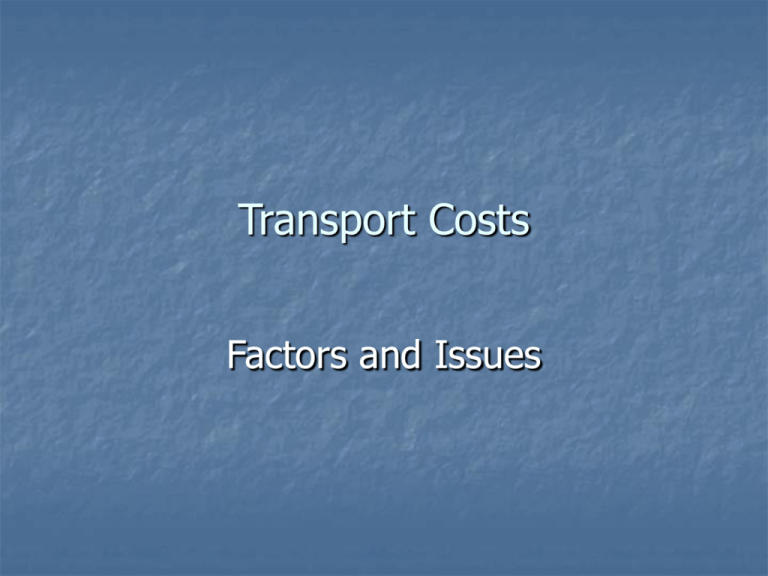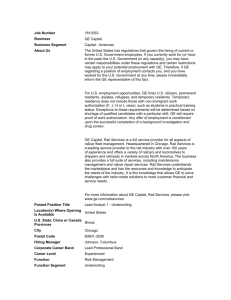Transport Costs

Transport Costs Factors and Issues
Components of Transport Cost
A Transaction Costs Friction of Space Shipment B
Distance, Modal Choice and Transport Costs
C1
Road
C2 C3 D1
Rail
D2
Maritime Distance
Shape of Transport Cost Curves
Many simple models, such as Von Thunen and Weber view transport costs as: 1. Proportional to distance 2. Each additional unit of distance adds an equal increment of cost In reality transport costs are less than proportional to distance—why?
Existence of fixed costs of transport facilities incurred regardless of length of journey Fixed or terminal costs (interest on capital, costs of maintaining plant and equipment, depreciation) dilute the unit cost as distance increases Therefore costs per mile tend to decline with increasing distance
Mode
Fixed and Operating Transport Costs
Fixed/Capital Costs Operating Costs
Rail or Highway Pipeline Air Maritime Land, Construction, Rolling Stock Land, Construction Land, Field & Terminal Construction, Aircraft Land for Port Terminals, Cargo Handling Equipment, Ships Maintenance, Labor, Fuel Maintenance, Energy Maintenance, Fuel, Labor Maintenance, Labor, Fuel
Fixed and Running Costs
Highway and trucking costs are only slightly less than proportional to distance This is due to very low terminal charges (fixed costs are only 10 % of total) Rail and Water- relatively high terminal charges but lower line haul costs Rail and Water networks are coarser than highway- fewer terminal facilities but larger in scale Containerization has helped reduced costs and port costs are becoming more and more efficient
Structure of Airline Costs
Fixed/Overhead- carrier’s capital especially aircraft
17 %
Operating-Direct-dependent on type of aircraft: flight crew, fuel, maintenance, depreciation, landing fees, leasing
60 %
Operating-Indirect- passenger related: passenger services, ticketing, station and ground costs, administrative
23%
Fixed and Variable Costs and Service in the Transportation System
Characteristic Fixed Infrastructure Variable Costs
Examples Ownership Lifespan Highways, rail tracks, airports, ports Mostly public Very long (decades) Rate of change Slow Impact on service Shapes accessibility Competition Level the playing field Trucks, railcars, planes, ships Mostly private Short to average (5 to 20 years) Rapid redeployment Shapes level of service Source of comparative advantages
Cost Variations in Transport
Postage Stamp Rates simplest possible structure – uniform rate irrespective of distance Blanket Rate similar rates for broad zones Example: Freight rates for lumber Origin zone: Washington/Oregon to: Montana- .76-100/ 100lbs Colorado-Wyoming- 1.11
Texas-Louisiana- 1.36
Minnesota-Nebraska, Kansas- 1.26
Tennessee, Alabama Georgia- 1.50
Indiana>>>>New England – 1.48 Distance Zones
Zonal Freight Rates
Real transport cost
D1 D2
Flat zonal rate I II III Distance IV
Cost Variations in Transport
Differences in Cost of Services: Loading characteristics light, bulky goods demand higher charges than heavy, compact articles Size of Shipment large, single consignments permit economies in administration and terminal costs Susceptibility to Loss and Damage and Risk Liability a. fragile and/or perishable goods- b. refrigerated, insulation and special packaging
Cost Variations in Transport
Elasticity of Demand better able to bear costs of transport than low value goods goods of high unit value are “charge what traffic will bear” Competition between Transport Modes Example: Rail wishes to compete with trucks on short haul must keep rates down Example: Rail Movement of Phosphate Rock from Tampa Norfolk .62 rate per ton/mile Lynchburg .95 Knoxville 1.10 Greensboro 1.11 Montgomery 1.37 Pensacola .97
Other examples: Wine ship Angelo Petri
Wine Ship and Transport Costs
Wine grapes- 80% come from California Tanker ships can penetrate the Central Valley converted oil tanker 26 stainless tanks 2.5 mil gals Shipped in bulk from California to East Coast Logistics problem of small region producing large amount of wine to distribute nationwide Shipping wine in bottles or bulk means large cost difference Rail only – bulk shipment from the West Coast to East and Midwest then bottled and shipped at higher rates Wine ship operation impacts- lowers rate by sea to bottling plants Wine ship competes with rail operations
Conditions Affecting Transport Costs
Condition
Geography Type of product Economies of scale Shipment size Trade imbalance Infrastructure Mode
Factors
Distance and accessibility Packaging, weight, perishable Empty travel- “back haul rates” Quality of Surface Capacity, limitations, operational conditions
Example
Long distance rates Seafood; time sensitive goods Container vs less than container Wine ship Natural disasters Air cargo; rail bulk; distance limits?
Conditions Affecting Transport Costs
Condition Factors Example
Elasticity of Demand High value versus Low value goods Grain vs. Fabrication in transit Uniform rate to capture business Grain to cereal Infrastrucure Competition and regulation Quality of surface Natural disasters; IHS Cost reductions to capture traffic Rail vs. highway
Transport and Market Areas
Market areas are carved out of space by interactions between supply and demand If product is standardized each market point will buy from production center that can supply it most cheaply Market areas are shaped by cheap or limited access routes which might expand market boundary Example: Inter-coastal trade via Panama Canal producers located on either coast can ship to the other coast more cheaply than rivals inland This route more and more important given jams in port facilities
Market Boundary Overlap
Boundaries between market areas are often blurred Implies absorption of distribution costs by buyer, seller or shipper Geographical Price Discrimination extra costs of long distance distribution not reflected in price of commodity Seller will profit by adjusting or taking control of delivered prices not in accord with transfer rates Push down price where competition is high and demand is elastic Push price upwards where competition is low and demand is inelastic Freight Absorption another form of geog price discrim Discriminate against near buyers so sellers assume transport costs to distant markets Sellers often has more intense competition in remote market than at home Freight absorption usually takes form of uniform price over large areas: toothpaste
Mode B
Modal Competition
Infrastructure / Route B B B Market Area B 1 2 A 3 4 5 6 A A A A
Average Length of Haul by Major Commodity Group, 2002
Gravel and crushed stone Gasoline and aviation turbine fuel Fuel oils Waste and scrap Alcoholic beverages Fertilizers Basic chemicals Wood products Coal Cereal grains Pharmaceutical products Machinery Plastics and rubber Electronic, electrical, and office equipment Textiles, leather, and products 0 100 200 300 400 500 600 700
Shipment Size and Transport Costs
10000000 1000000 100000 10000 1000 100 10 1 Shipment Size (lbs) Transport Charges ($/ton) Parcel LTL Truck Truckload Railcar load Multi railcar Unit train Barge load
Top 10 Commodity Groups Ranked by Value Per Ton, United States, 2002
Pharmaceutical products Electronic, electrical, and office equipment Transportation equipment, n.e.c.
Precision instruments and apparatus Tobacco products Textiles, leather, and products Machinery Motorized and other vehicles and parts Miscellaneous manufactured products Furniture, mattresses and lighting products CFS total 0 4,000 8,000 12,000 16,000 20,000
Transport Costs by Industry Type, 1999
Finance, Insurance & Real Estate Services Wholesale & Retail Communications & Utilities Manufacturing Construction Mining Agriculture, Forestry & Fishing 0 1 2 3 4 5 6 Transport costs per output (%) 7 8 9
FOB and CIF Transport Costs
}
Production Costs Distance Freight-on-Board Cost-Insurance-Freight
CIF and FOB
CIF- trade term requiring the seller to arrange for the carriage of goods by sea to a port of destination, and provide the buyer with the documents necessary to obtain the goods from the carrier. FOB- A trade term requiring the seller to deliver goods on board a vessel designated by the buyer. The seller fulfills his obligations to deliver when the goods have passed over the ship's rail. When used in trade terms, the word "free" means the seller has an obligation to deliver goods to a named place for transfer to a carrier



